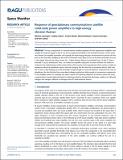Response of geostationary communications satellite solid-state power amplifiers to high-energy electron fluence
Author(s)
Lohmeyer, Whitney; Carlton, Ashley; Wong, Frankie; Bodeau, Michael; Kennedy, Andrew; Cahoy, Kerri; ... Show more Show less
DownloadLohmeyer 2015 AGU Space Weather.pdf (1.664Mb)
Metadata
Show full item recordAbstract
The key components in communications satellite payloads are the high-power amplifiers that amplify the received signal so that it can be accurately transmitted to the intended end user. In this study, we examine 26 amplifier anomalies and quantify the high-energy electron environment for periods of time prior to the anomalies. Building on the work of Lohmeyer and Cahoy (2013), we find that anomalies occur at a rate higher than just by chance when the >2 MeV electron fluence accumulated over 14 and 21 days is elevated. To try to understand “why,” we model the amplifier subsystem to assess whether the dielectric material in the radio frequency (RF) coaxial cables, which are the most exposed part of the system, is liable to experience electrical breakdown due to internal charging. We find that the accumulated electric field over the 14 and 21 days leading up to the anomalies is high enough to cause the dielectric material in the coax to breakdown. We also find that the accumulated voltages reached are high enough to compromise components in the amplifier system, for example, the direct current (DC) blocking capacitor. An electron beam test using a representative coaxial cable terminated in a blocking capacitor showed that discharges could occur with peak voltages and energies sufficient to damage active RF semiconductor devices.
Date issued
2015-05-25Department
Space Telecommunications Astronomy and Radiation (STAR) Lab; Massachusetts Institute of Technology. Department of Aeronautics and AstronauticsPublisher
AGU Space Weather
Citation
Lohmeyer, W., A. Carlton, F. Wong, M. Bodeau, A. Kennedy, and K. Cahoy (2015), Response of geostationary communications satellite solid-state power amplifiers to high-energy electron fluence, Space Weather, 13, 298–315, doi:10.1002/2014SW001147.